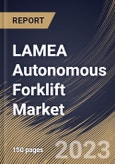The adoption of automation solutions has grown dramatically in recent years since they are reliable options for material handling, increasing the industries' production capacity. The physical damage to the goods - typically brought on by human operators - is reduced, and operating efficiency is increased using these material handling solutions. Almost all industries, including manufacturing, food & beverage, logistics, and automotive, have implemented autonomous forklifts.
Additionally, e-commerce businesses implement autonomous solutions to boost productivity and lower personnel costs. Therefore, rising automation requirements will also increase demand for autonomous forklifts. Aside from that, autonomous material handling systems save on expenses related to labor, training, healthcare, and the damage manual forklifts cause to buildings, equipment, and unsold goods.
Traditional forklift operators suffer additional labor expenses that machines cannot automate and can be boiled down to conceptual, value-added jobs that can be distributed more strategically. It can be challenging for firms to retain well-trained forklift operators due to rising labor prices, the availability of full-time workers, changing workforce demographics, and other factors. In addition to creating costly training courses for new hires and departing operators, high turnover also results in a developing labor scarcity as the market's need for competent workers rises constantly.
The Saudi Arabian Government’s efforts to lessen reliance on the oil and gas sector and to invest heavily in domestic manufacturing, including the pharmaceutical, automotive, and food processing sectors, will increase demand for automation as well as assembly technology. In addition, the region's expanding industrial sector, as a result of programs like the National Industrial Development and Logistics Program and the Dubai Industrial Strategy 2030, along with several upcoming non-oil projects, will continue to play a significant role in the expansion of the UAE's factory automation. As a result, the regional market will grow rapidly due to the rising efforts of automating factory and industry processes.
The Brazil market dominated the LAMEA Autonomous Forklift Market by Country in 2022; thereby, achieving a market value of $185.7 million by 2029. The Argentina market is showcasing a CAGR of 16.4% during (2023-2029). Additionally, The UAE market would register a CAGR of 15.5% during (2023-2029).
Based on Type, the market is segmented into Pallet Jacks and Pallet Stackers. Based on Application, the market is segmented into Material Handling, Warehousing, Logistics & Freight, Manufacturing and Others. Based on Navigation Technology, the market is segmented into Vision Guidance, Laser Guidance, Magnetic & Inductive Guidance, Optical Tape Guidance and SLAM & Others. Based on Tonnage Capacity, the market is segmented into Below 5 Tons, 5-10 Tons and Above 10 Tons. Based on Operation Type, the market is segmented into Indoor and Outdoor. Based on Propulsion Type, the market is segmented into Electric and ICE & Others. Based on Vertical, the market is segmented into Food & Beverages, 3PL, Healthcare, Automotive & Aviation, Retail & Ecommerce, Paper & Pulp, Electronics & Semiconductors and Others. Based on countries, the market is segmented into Brazil, Argentina, UAE, Saudi Arabia, South Africa, Nigeria, and Rest of LAMEA.
The market research report covers the analysis of key stake holders of the market. Key companies profiled in the report include Mitsubishi Logisnext Co., Ltd., Toyota Industries Corporation, Oceaneering International, Inc., Kuka AG (Swisslog Holding AG), Hyster-Yale Materials Handling, Inc., Hyundai Construction Equipment Co., Ltd. (Hyundai Heavy Industries Co., Ltd.), Jungheinrich AG, Balyo, KION GROUP AG and AGILOX Services GmbH
Scope of the Study
By Type
- Pallet Jacks
- Pallet Stackers
By Application
- Material Handling
- Warehousing
- Logistics & Freight
- Manufacturing
- Others
By Navigation Technology
- Vision Guidance
- Laser Guidance
- Magnetic & Inductive Guidance
- Optical Tape Guidance
- SLAM & Others
By Tonnage Capacity
- Below 5 Tons
- 5-10 Tons
- Above 10 Tons
By Operation Type
- Indoor
- Outdoor
By Propulsion Type
- Electric
- ICE & Others
By Vertical
- Food & Beverages
- 3PL
- Healthcare
- Automotive & Aviation
- Retail & Ecommerce
- Paper & Pulp
- Electronics & Semiconductors
- Others
By Country
- Brazil
- Argentina
- UAE
- Saudi Arabia
- South Africa
- Nigeria
- Rest of LAMEA
Key Market Players
List of Companies Profiled in the Report:
- Mitsubishi Logisnext Co., Ltd.
- Toyota Industries Corporation
- Oceaneering International, Inc.
- Kuka AG (Swisslog Holding AG)
- Hyster-Yale Materials Handling, Inc.
- Hyundai Construction Equipment Co., Ltd. (Hyundai Heavy Industries Co., Ltd.)
- Jungheinrich AG
- Balyo
- KION GROUP AG
- AGILOX Services GmbH
Unique Offerings
- Exhaustive coverage
- The highest number of Market tables and figures
- Subscription-based model available
- Guaranteed best price
- Assured post sales research support with 10% customization free
Table of Contents
Companies Mentioned
- Mitsubishi Logisnext Co., Ltd.
- Toyota Industries Corporation
- Oceaneering International, Inc.
- Kuka AG (Swisslog Holding AG)
- Hyster-Yale Materials Handling, Inc.
- Hyundai Construction Equipment Co., Ltd. (Hyundai Heavy Industries Co., Ltd.)
- Jungheinrich AG
- Balyo
- KION GROUP AG
- AGILOX Services GmbH
Methodology

LOADING...








